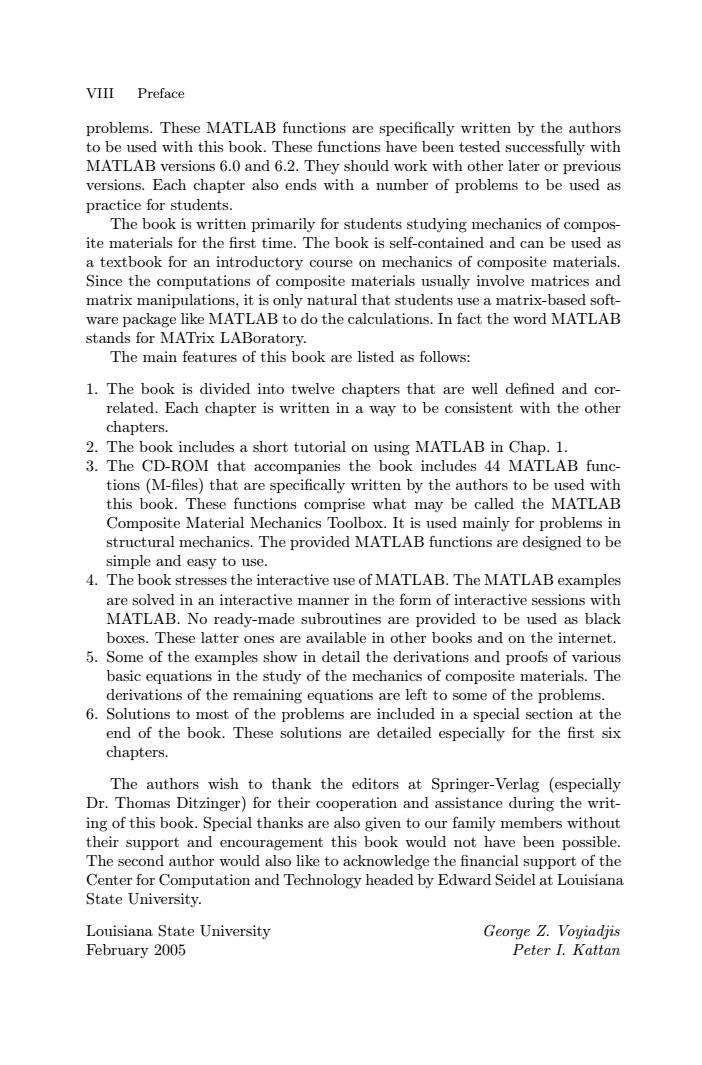正在加载图片...

VIII Preface problems.These MATLAB functions are specifically written by the authors to be used with this book.These functions have been tested successfully with MATLAB versions 6.0 and 6.2.They should work with other later or previous versions.Each chapter also ends with a number of problems to be used as practice for students. The book is written primarily for students studying mechanics of compos- ite materials for the first time.The book is self-contained and can be used as a textbook for an introductory course on mechanics of composite materials. Since the computations of composite materials usually involve matrices and matrix manipulations,it is only natural that students use a matrix-based soft- ware package like MATLAB to do the calculations.In fact the word MATLAB stands for MATrix LABoratory. The main features of this book are listed as follows: 1.The book is divided into twelve chapters that are well defined and cor- related.Each chapter is written in a way to be consistent with the other chapters. 2.The book includes a short tutorial on using MATLAB in Chap.1. 3.The CD-ROM that accompanies the book includes 44 MATLAB func- tions(M-files)that are specifically written by the authors to be used with this book.These functions comprise what may be called the MATLAB Composite Material Mechanics Toolbox.It is used mainly for problems in structural mechanics.The provided MATLAB functions are designed to be simple and easy to use. 4.The book stresses the interactive use of MATLAB.The MATLAB examples are solved in an interactive manner in the form of interactive sessions with MATLAB.No ready-made subroutines are provided to be used as black boxes.These latter ones are available in other books and on the internet. 5.Some of the examples show in detail the derivations and proofs of various basic equations in the study of the mechanics of composite materials.The derivations of the remaining equations are left to some of the problems. 6.Solutions to most of the problems are included in a special section at the end of the book.These solutions are detailed especially for the first six chapters. The authors wish to thank the editors at Springer-Verlag (especially Dr.Thomas Ditzinger)for their cooperation and assistance during the writ- ing of this book.Special thanks are also given to our family members without their support and encouragement this book would not have been possible. The second author would also like to acknowledge the financial support of the Center for Computation and Technology headed by Edward Seidel at Louisiana State University. Louisiana State University George Z.Voyiadjis February 2005 Peter I.KattanVIII Preface problems. These MATLAB functions are specifically written by the authors to be used with this book. These functions have been tested successfully with MATLAB versions 6.0 and 6.2. They should work with other later or previous versions. Each chapter also ends with a number of problems to be used as practice for students. The book is written primarily for students studying mechanics of composite materials for the first time. The book is self-contained and can be used as a textbook for an introductory course on mechanics of composite materials. Since the computations of composite materials usually involve matrices and matrix manipulations, it is only natural that students use a matrix-based software package like MATLAB to do the calculations. In fact the word MATLAB stands for MATrix LABoratory. The main features of this book are listed as follows: 1. The book is divided into twelve chapters that are well defined and correlated. Each chapter is written in a way to be consistent with the other chapters. 2. The book includes a short tutorial on using MATLAB in Chap. 1. 3. The CD-ROM that accompanies the book includes 44 MATLAB functions (M-files) that are specifically written by the authors to be used with this book. These functions comprise what may be called the MATLAB Composite Material Mechanics Toolbox. It is used mainly for problems in structural mechanics. The provided MATLAB functions are designed to be simple and easy to use. 4. The book stresses the interactive use of MATLAB. The MATLAB examples are solved in an interactive manner in the form of interactive sessions with MATLAB. No ready-made subroutines are provided to be used as black boxes. These latter ones are available in other books and on the internet. 5. Some of the examples show in detail the derivations and proofs of various basic equations in the study of the mechanics of composite materials. The derivations of the remaining equations are left to some of the problems. 6. Solutions to most of the problems are included in a special section at the end of the book. These solutions are detailed especially for the first six chapters. The authors wish to thank the editors at Springer-Verlag (especially Dr. Thomas Ditzinger) for their cooperation and assistance during the writing of this book. Special thanks are also given to our family members without their support and encouragement this book would not have been possible. The second author would also like to acknowledge the financial support of the Center for Computation and Technology headed by Edward Seidel at Louisiana State University. Louisiana State University George Z. Voyiadjis February 2005 Peter I. Kattan